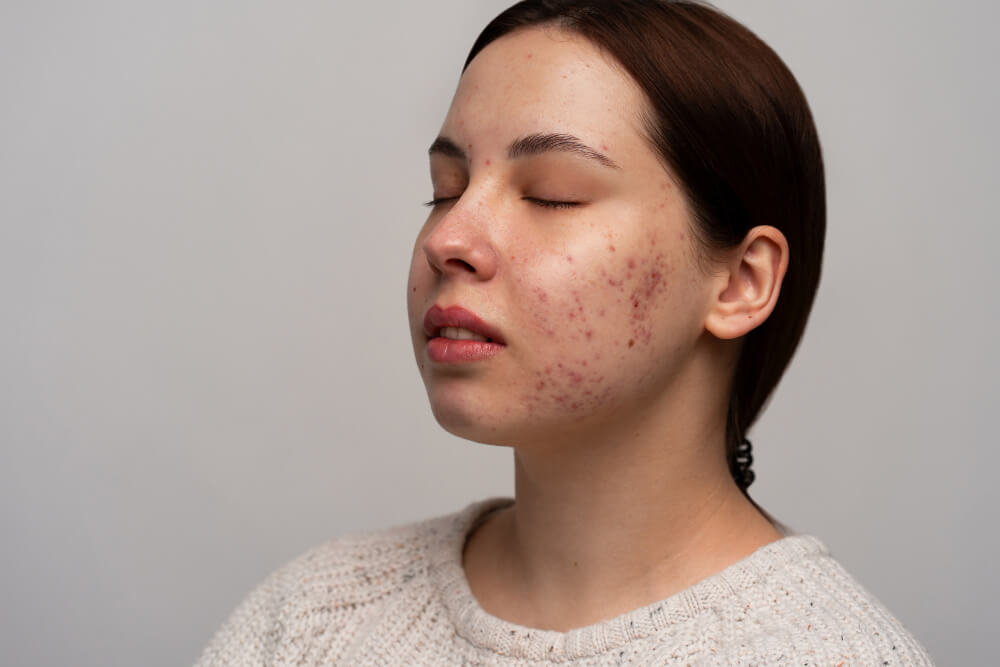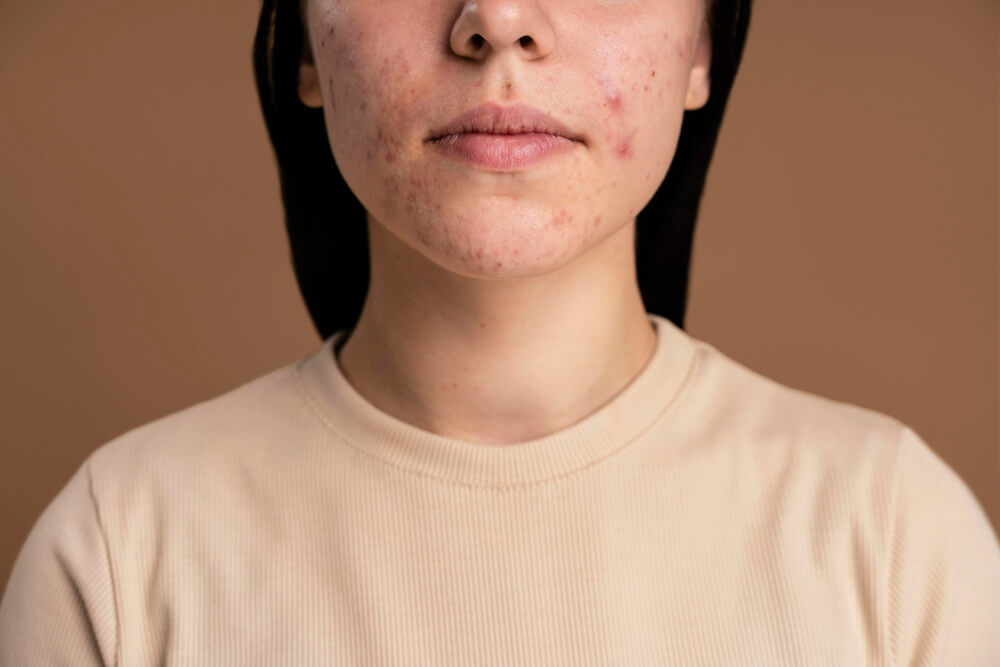Hormonal acne is a prevalent condition in Singapore, affecting many individuals beyond their teenage years into adulthood. The condition is largely driven by hormonal fluctuations, which can trigger the overproduction of oil, leading to acne flare-ups.
For those dealing with hormonal acne, it is important to understand the underlying condition and to seek appropriate treatment early to manage outbreaks and prevent long-term skin damage.

Table of Contents
ToggleWhat is hormonal acne?
Fluctuations in hormone levels, particularly androgens such as testosterone, can induce increased sebum production from the sebaceous glands. This excess sebum can lead to clogged pores and the subsequent formation of acne lesions.
This type of acne commonly appears around the jawline, cheeks, and chin. It can range from mild, with occasional breakouts, to severe cystic forms characterized by deep, painful nodules beneath the skin’s surface.
Hormonal acne is prone to be persistent and does not respond as effectively to conventional treatments. It is crucial to identify the underlying hormonal imbalances driving this condition for devising effective treatment strategies that address its root cause.
Stress acne vs hormonal acne
Stress acne and hormonal acne are distinct. Stress acne is commonly triggered by elevated levels of stress leading to increased cortisol production, and hormonal acne is driven by fluctuations in hormone levels.
Stress acne typically manifests as small, superficial pimples. It may appear on various areas of the face, while hormonal acne tends to occur predominantly along the jawline, chin, and cheeks and can range from mild to severe cystic forms.
While stress acne and hormonal acne have different underlying causes, they both contribute to acne breakouts. As such, different approaches for effective management may be needed, with stress reduction techniques being beneficial for stress acne and addressing hormonal imbalances being necessary for hormonal acne management.
Hormonal acne vs regular acne
Hormonal acne and regular acne both involve the development of acne lesions but have different underlying causes and characteristics.
In contrast to hormonal acne, regular acne, or acne vulgaris, can result from various factors such as excess oil production, bacteria, inflammation, and genetics. It may present as different types of lesions on the face, chest, back, or shoulders. Understanding these differences is essential for tailoring effective treatment approaches.
What causes hormonal acne?
Hormonal acne is mainly driven by fluctuations in hormone levels, resulting in heightened sebum production and skin inflammation.
These changes commonly occur during menopause, puberty, menstruation, and in conjunction with conditions like polycystic ovary syndrome (PCOS) and elevated androgen levels. Stress further contributes to hormonal imbalance, amplifying acne symptoms.
What causes hormonal acne in males?
Hormonal acne is often caused by high levels of androgens, such as testosterone, in males. These androgens can increase the production of sebum in the skin’s oil glands, leading to clogged pores and acne outbreaks.
Stress and diet are other common factors that contribute to the severity of acne in males. Hormonal fluctuations are more pronounced during puberty but can also affect adult males due to lifestyle factors or health conditions that alter hormone levels.
What causes hormonal acne in females?
In females, hormonal acne is commonly linked to the menstrual cycle, pregnancy, menopause, and conditions that affect hormone levels. For instance, Polycystic Ovarian Syndrome (PCOS). The shift in hormonal levels, specifically a rise in androgens, may lead to higher sebum production, clogged pores and acne.
Which hormone causes acne in females?
The primary hormones implicated in the development of acne in females are androgens, such as testosterone. Even though androgens are often thought of as male hormones, they are also present in women and can significantly influence skin conditions, leading to the production of excess oil.
Hormonal acne during period
During menstrual periods, fluctuations in hormone levels, especially a relative increase in androgens compared to estrogen and progesterone, can lead to breakouts. This hormonal imbalance enhances sebum production, contributing to the development of acne on the skin.
Hormonal acne signs
Hormonal acne is characterized by deeply rooted, often painful pimples which are unlike surface-level pimples caused by bacteria.
These breakouts are typically more resistant to traditional acne treatments and may worsen with stress.
Where does hormonal acne usually show up?
Hormonal acne predominantly appears in areas rich in oil glands, particularly where the skin is sensitive to hormonal changes. The distribution often helps in identifying whether acne is hormonal.
Hormonal acne on cheeks
Acne breakouts on the cheeks can be caused by fluctuating hormone levels. This area can show larger, inflamed pimples that are painful to the touch. Cheek acne is particularly stubborn and may flare up with cycles of hormonal changes.

Hormonal chin acne
The chin is a common hotspot for hormonal acne. It typically presents as clusters of cystic acne that can be painful and swollen. These breakouts are closely tied to hormonal shifts during menstrual cycles.
Jawline hormonal acne
When acne appears along the jawline, it’s often a sign of hormonal imbalances. It is called cystic acne, and is deeper and more painful than regular pimples. The jawline is sensitive to changes in hormones in the body.
Hormonal forehead acne
Hormonal acne in the forehead area shows up as smaller pimples that might not be as deep as the ones on the lower part of the face. However, these pimples can stick around or get worse when hormones change.
Hormonal acne on neck
Acne on the neck might suggest hormonal issues. It appears as painful, deep, cystic pimples that are difficult to treat with over-the-counter skincare products.
Hormonal acne on female back
In females, hormonal factors can cause acne on the back, especially in parts like the upper and lower back, where there are many oil glands. This acne can be bigger, more swollen, and hard to get rid of, often needing treatment beyond the usual skincare products.
How to treat hormonal acne?
While acne can be unsightly and painful, leading to issues such as self-confidence, there are treatments available.
Facial treatments
Treatments such as acne facials can help treat and manage this condition. Below are some specific skin care treatments that might be suitable for you, depending on the severity and cause of acne.
Menopause skin and acne treatment
Menopausal skin often experiences acne flare-ups due to hormonal fluctuations. Specific treatments, such as gentle, hydrating facials, are tailored to manage these changes without irritating sensitive skin.
Menopause skin and acne treatment is a 90-minute facial designed for menopausal skin that includes skin-revitalizing actives, essential oils, and massages to balance hormones and improve skin elasticity. The treatment ends with a nourishing mask to restore, lift, and firm the skin, emphasizing personalized care and high-quality ingredients for optimal skin health.
Clogged pores treatment
Treatments for clogged pores, like microdermabrasion or chemical peels, effectively manage acne by removing dead skin cells and impurities. The clean pores facial is a 90-minute session that targets clogged pores and hormonal acne using Hyperbaric Oxygen Botanical Solution and Magnetic Infusion Technology to balance sebum, hydrate skin, and prevent acne.
This treatment includes a personalized skin diagnosis, double cleansing, exfoliation, steaming, extractions, a signature massage, a custom hydrojelly mask, serum infusion, moisturizer, and sunblock, making it ideal for oily, congested, acne-prone skin, including maskne.
Perimenopause treatment
Similar to menopause treatments, perimenopausal acne treatments focus on balancing skin needs during hormonal changes with non-aggressive, hydrating, and calming facials.
The facial for perimenopausal women uses Bio-Regulating Renewal Cream and Indiba’s ProIonic action to rejuvenate the skin, enhance cellular function, boost collagen production, and detoxify it. It also addresses hormonal acne, dullness, and dehydration, including double cleansing, exfoliation, and a signature massage.
Facial treatment for men
Facial treatments for men focus on deep cleansing and exfoliation to manage oiliness and prevent acne, tailored to the thicker, oilier nature of male skin.
The facial, designed for men with congested, acne-prone skin, is a 75-minute session that includes double cleansing, exfoliation, steaming, extractions, and advanced technologies like Magnetic Infusion and Hyperbaric Oxygen Infusion.
It also features a customized Hydrojelly mask and serum to regulate sebum, reduce irritation and redness, and prevent signs of ageing, restoring the skin’s natural balance.
Medical treatments
Topical retinoids and retinol products are often recommended for their effectiveness in treating hormonal acne by promoting cell turnover and reducing inflammation. The best retinol for hormonal acne typically depends on skin tolerance and the severity of the condition.
Comparatively, benzoyl peroxide is effective for killing bacteria and helping to clear up acne quickly, while salicylic acid works well to penetrate clogged pores and exfoliate the skin. The choice between these two often depends on skin type and acne severity.
Dietary and lifestyle adjustments
Hormonal acne diet
A diet low in dairy and high glycemic foods can help reduce acne outbreaks. Incorporating omega-3 fatty acids, antioxidants, and fibre rich foods support skin health and reduces inflammation.
Foods to avoid
Avoiding dairy products, sugary foods, and refined carbohydrates can help manage hormonal acne. This is because doing so reduces inflammation and insulin spikes.

Supplements and probiotics
Zinc, vitamin D, omega-3 fatty acids, and probiotics can support skin health and hormonal balance, potentially reducing the severity of acne.
How to prevent hormonal acne?
Maintaining a balanced diet low in dairy and high-glycemic foods can help prevent breakouts. Consuming foods that are rich in omega-3 fatty acids, antioxidants, and fibre would also help.
Managing and relieving stress through activities like yoga or meditation is not just beneficial for your mental health, but also for your skin. Additionally, staying hydrated, refraining from face-touching, engaging in regular exercise, and ensuring adequate sleep are all important factors in preventing hormonal acne.
Consult a healthcare provider for hormonal treatments, if necessary, to further help regulate hormones and prevent acne outbreaks.
What is the best skincare routine for hormonal acne?
A gentle skincare routine inclusive of cleansing, moisturizing, and the use of non-comedogenic products is vital. Incorporating ingredients like salicylic acid and benzoyl peroxide can help manage and prevent flare-ups.
Where to get hormonal acne treatment in Singapore?
In Singapore, hormonal acne treatments tailored to individual skin types and acne severity are available at TaraBliss.
Additionally, TaraBliss offers various skincare services, including facials like the Meridian Fitness Facial and Digital Detox Facial, targeting concerns such as acne, aging, and sensitivity.
TaraBliss’s experienced, award-winning team emphasizes a holistic skincare approach, integrating wellness practices to enhance beauty and well-being.
FAQ
What does hormonal acne look like?
Hormonal acne usually manifests as red, inflamed pimples around the chin, jawline, and lower face and may also include cysts, blackheads, and whiteheads.
Why does hormonal acne itch?
Hormonal acne can itch because of skin inflammation and irritation. The body’s immune response to bacteria and debris clogging the pores can cause itchiness. Additionally, dryness or overuse of acne treatments can further irritate the skin, resulting in itching.
Can working out cause hormonal acne?
Sweat from working out can exacerbate acne by clogging pores, though exercise itself does not cause acne.
To minimize sweat’s impact, shower promptly with lukewarm water and a gentle cleanser. This quick wash removes sweat, oil, and dead skin cells, preventing clogged pores and breakouts.
Why is my hormonal acne flaring up?
Hormonal acne flare-ups can result from hormonal changes during menstruation, pregnancy, menopause, or conditions like PCOS, as well as increased stress, high-glycemic diets, dairy consumption, pore-clogging skincare products, certain medications, and lack of sleep.
How long does hormonal acne last?
Hormonal acne can persist for several years, often occurring during hormonal changes like puberty, menstrual cycles, pregnancy, or menopause. Its duration varies per individual, ranging from a few months to several years, depending on the underlying hormonal causes and how they are managed.
How can I balance my hormones to reduce acne?
Stress management, a balanced diet, and regular exercise are some lifestyle changes that can help, along with medical treatments if necessary.
How often should I wash my face if I have hormonal acne?
If you have hormonal acne, wash your face with a gentle cleanser that is tailored for acne-prone skin. However, avoid overwashing to prevent skin irritation and exacerbation of acne.
Should you moisturize hormonal acne?
Yes, using a non-comedogenic moisturizer can help maintain skin barrier function and prevent irritation.
At what age does hormonal acne get better?
Hormonal acne may start improving in the late teens or early twenties but can persist into adulthood due to hormone fluctuations.
How to tell if acne is hormonal or bacterial?
Hormonal acne typically follows a pattern linked to hormonal changes. It affects the lower part of the face, while bacterial acne can occur anywhere and may respond quickly to topical antibiotics.
Conclusion
Hormonal acne management requires a holistic approach that includes targeted treatments and lifestyle adjustments. By understanding the underlying hormonal imbalances and implementing personalized skincare regimens, individuals can effectively manage and prevent acne breakouts. For persistent or severe cases, consulting with a skin specialist to develop a comprehensive treatment plan tailored to the individual’s needs is advisable.




